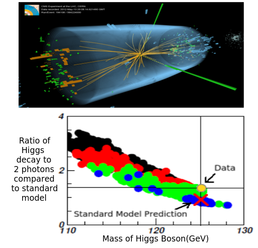Exploring Higgs Boson Physics Beyond the Standard Model
- Started
- 1st October 2012
- Research Team
- Marc Thomas
- Investigators
- Alexander Belyaev

Top: A particle collision producing a Higgs Boson at CERN. Bottom: A plot showing that data for Higgs decays does not agree with the Standard Model, but can be explained by the Minimal Supersymmetric Model.
Background
The 'Standard Model' is the current best model that we have for describing the elementary particles. However, we know that it cannot be the whole story as there are a number of things it is unable to explain. It doesn't include gravity at all, it can't explain 'Dark Matter', which is the name given to matter that we have never seen here on Earth, but we can see exists from astrophysical observations of galaxies, and it predicts that half of the universe should be made of antimatter, which it is not! There are very many 'Beyond Standard Model' (BSM) theories which improve on the Standard Model by solving some of these problems.
Project and Results
The purpose of this project is to look for signs of these BSM theories in processes involving the Higgs Boson at the Large Hadron Collider.
Iridis has, and will prove essential in enabling me to complete this study. Thus far, I have used Iridis to simulate extremely challenging particle collision processes with 5 and 6 final state particles, using simulation packages CalcHEP and MadGraph. This produced published results showing that BSM physics could produce a large increase in the amount of scattering produced. I was able to run these simulations in a few days using parallel processing on Iridis, whilst this would have been unfeasible, taking up to 100 times longer on my desktop.
Iridis has also enabled me to scan over 5 million points in a 14-dimensional parameter space, a task which would have taken over 40 days of continuous running time on my desktop. This has allowed me to show that the unexplained excess of the Higgs Boson decaying to 2 photons which has recently been observed at CERN can be explained using the Minimal Supersymmetric Model (a leading candidate BSM theory).
My project contributes original research to fundamental particle physics, and the majority of my work involves either complex simulations or scanning very large, multi-dimensional parameter spaces. Iridis has and will continue to be essential in enabling me to do this.
Categories
Physical Systems and Engineering simulation: Particle Collisions
Algorithms and computational methods: Monte Carlo